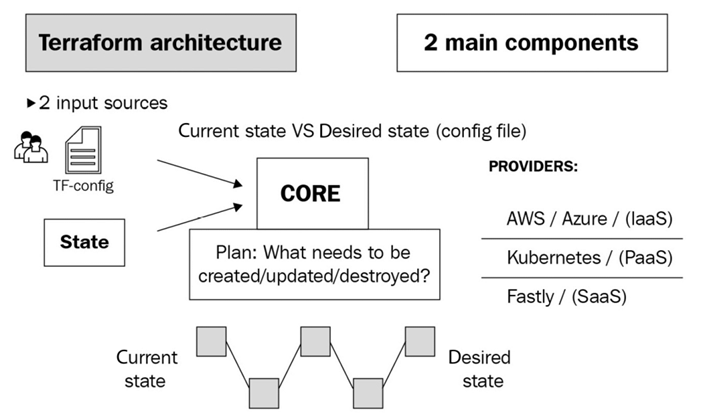IaC is the concept of using code to define infrastructure. While most people can visualize infrastructure as something tangible, virtual infrastructure is already commonplace and has existed for around two decades. Cloud providers provide a web-based console through which you can manage your infrastructure intuitively. But the process is not repeatable or recorded.
If you spin up a set of infrastructure components using the console in one environment and want to replicate it in another, it is a duplication of effort. To solve this problem, cloud platforms provide APIs to manipulate resources within the cloud and some command-line tools that can help trigger the APIs. You can start writing scripts using commands to create the infrastructure and parameterize them to use the same scripts in another environment. Well, that solves the problem, right?
Not really! Writing scripts is an imperative way of managing infrastructure. Though you can still call it IaC, its problem is that it does not effectively manage infrastructure changes. Let me give you a few examples:
- What would happen if you needed to modify something already in the script? Changing the script somewhere in the middle and rerunning the entire thing may create havoc with your infrastructure. Imperative management of infrastructure is not idempotent. So, managing changes becomes a problem.
- What if someone manually changes the script-managed infrastructure using the console? Will your script be able to detect it correctly? What if you want to change the same thing using a script? It will soon start to get messy.
- With the advent of hybrid cloud architecture, most organizations use multiple cloud platforms for their needs. When you are in such a situation, managing multiple clouds with imperative scripts soon becomes a problem. Different clouds have different ways of interacting with their APIs and have distinct command-line tools.
The solution to all these problems is a declarative IaC solution such as Terraform. HashiCorp’s Terraform is the most popular IaC tool available on the market. It helps you automate and manage your infrastructure using code and can run on various platforms. As it is declarative, you just need to define what you need (the desired end state) instead of describing how to achieve it. It has the following features:
- It supports multiple cloud platforms via providers and exposes a single declarative HashiCorp Configuration Language (HCL)-based interface to interact with it. Therefore, it allows you to manage various cloud platforms using a similar language and syntax. So, having a few Terraform experts within your team can handle all your IaC needs.
- It tracks the state of the resources it manages using state files and supports local and remote backends to store and manage them. That helps in making the Terraform configuration idempotent. So, if someone manually changes a Terraform-managed resource, Terraform can detect the difference in the next run and prompt corrective action to bring it to the defined configuration. The admin can then absorb the change or resolve any conflicts before applying it.
- It enables GitOps in infrastructure management. With Terraform, you can have the infrastructure configuration alongside application code, making versioning, managing, and releasing infrastructure the same as managing code. You can also include code scanning and gating using pull requests so that someone can review and approve the changes to higher environments before you apply them. A great power indeed!
Terraform has multiple offerings – open source, cloud , and enterprise. The open source offering is a simple command- line interface (CLI)-based tool that you can download on any supported operating system (OS) and use. The cloud and enterprise offerings are more of a wrapper on top of the open source one. They provide a web-based GUI and advanced features such as policy as code with Sentinel, cost analysis, private modules, GitOps, and CI/CD pipelines.
This chapter will discuss the open source offering and its core functions.
Terraform open source is divided into two main parts – Terraform Core and Terraform providers, as seen in the following diagram:

Figure 8.1 – Terraform architecture
Let’s look at the functions of both components:
- Terraform Core is the CLI that we will use to interact with Terraform. It takes two main inputs – your Terraform configuration files and the existing state. It then takes the difference in configuration and applies it.
- Terraform providers are plugins that Terraform uses to interact with cloud providers. The providers translate the Terraform configuration into the respective cloud’s REST API calls so that Terraform can manage its associated infrastructure. For example, if you want Terraform to manage AWS infrastructure, you must use the Terraform AWS provider.
Now let’s see how we can install open source Terraform.


